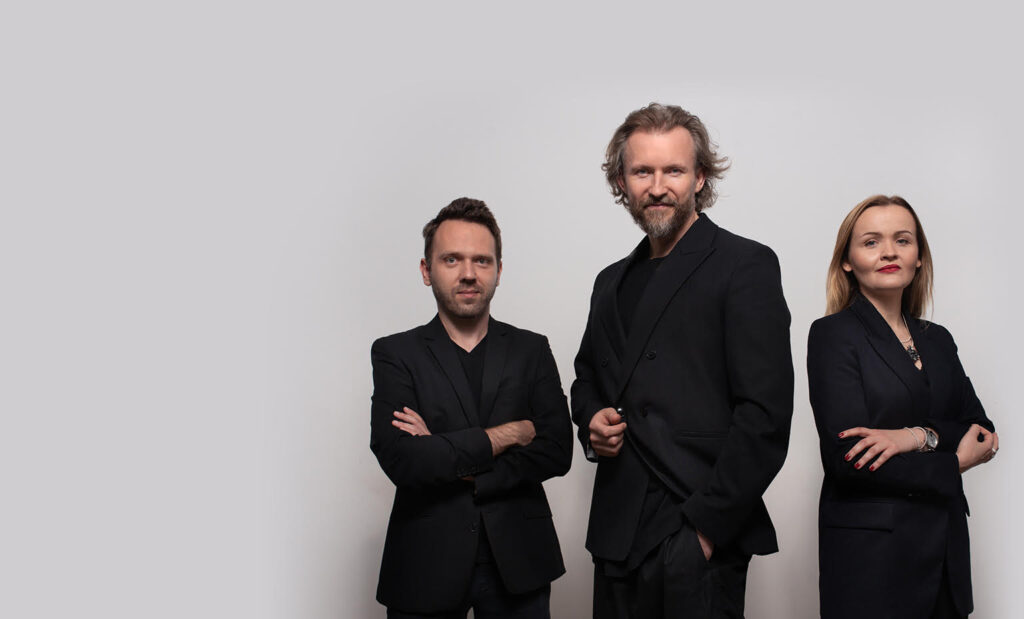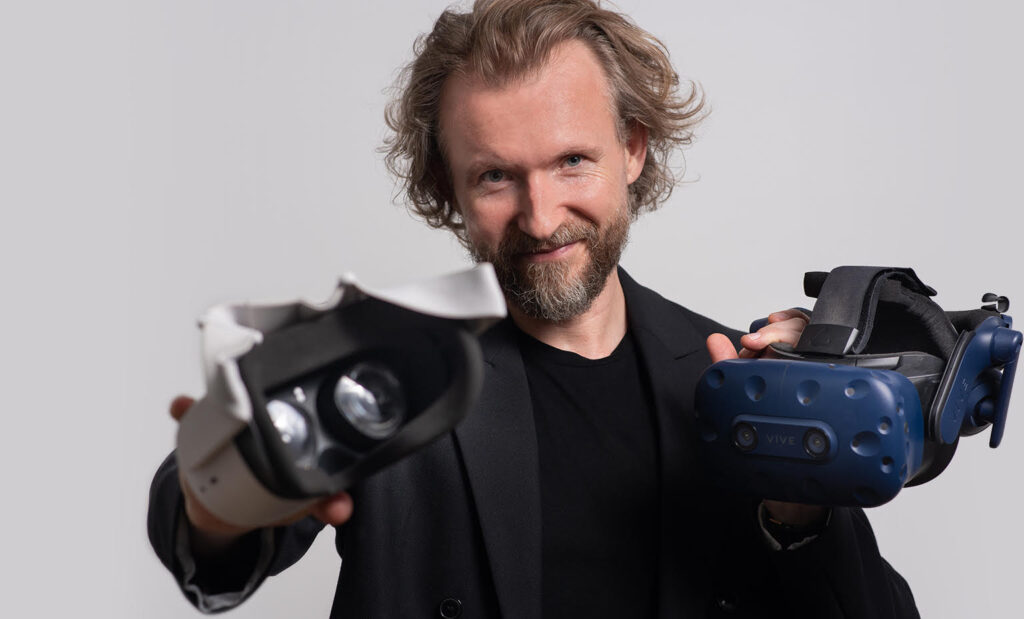Interview with artificial intelligence!
Why are people afraid of artificial intelligence?

We create content
& VR, AR, Metaverse applications

We educate how to effectively
implement innovations

We reinforce the client's
media presence





For over 10 years, we have been implementing comprehensive implementations of VR and AR applications on all available platforms and devices. We have our own 3D studio that provides content for all ongoing projects. Behind each of our projects is a team of Innovators. We guarantee the highest quality of service.
We use technologies of the future,
such as augmented reality (AR),
virtual reality (VR).
We use technologies of the future, such as augmented reality (AR), virtual reality (VR).

We have completed several dozen winning implementations of innovations, thanks to which our clients increased their profit and achieved business goals.

Stay ahead of the competition.

Sell more.

Execute quickly innovative projects.
Angażujesz zbyt dużo zasobów w edukację nowych pracowników?
Boisz się, że konkurencja wyprzedzi Cię wprowadzając automatyzację?
Masz zbyt długi proces szkolenia pracowników?
Masz skomplikowane procesy?
Przestoje w produkcji spędzają ci sen z powiek?
Pracownicy nie chcą się uczyć?
![]()
![]()
![]()
![]()
![]()
Bądź szybszy niż Twoja konkurencja.
Zacznij terazWe come from business and work with the best people. We know that business is there to earn money. All activities undertaken by you within the organization should increase the value of your company. Are you wondering what advantage do we have by understanding this matter? Our actions are to result in a positive business result in your company. This is the mission of Connected Realities.
Increase efficiency of your business.
We always emphasize that we are not sellers of one solution. It is important for us to understand your business goals before starting any project. We realize that there are no universal solutions for business, which is why we use a wide range of technological tools to quickly and effectively respond to your needs. Our experience of working with both small and large companies allows us to understand how different industries work and what they need from their software.
Be faster than your competitors.
Why are people afraid of artificial intelligence?
I observe that often the budget, which is planned at the beginning of the project, ends with the completion of work related to it. Horror!
Where do I get my knowledge from? Always from practice. My company ConnectedRealities.eu implements min. specialized trainings for the industry using Virtual Reality (VR) and Augmented Reality (AR) technologies.
Wirtualna rzeczywistość, virtual reality, VR – umożliwia użytkownikom VR na obecność w cyfrowo odwzorowanej przestrzeni świata rzeczywistego lub doświadczenie warunków, które byłyby niemożliwe do osiągnięcia w prawdziwym świecie. Trójwymiarowa przestrzeń VR może zostać stworzona za pomocą grafiki, animacji, video, fotografii lub być kombinacją tych elementów. Posiadać formę interaktywną i statyczną.
VR is an abbreviation of virtual reality. It enables users to be present in a digitally mapped space of the real world or experience conditions that would be impossible to achieve in the real world. Three-dimensional VR space can be created using graphics, animation, video, photography or a combination of these elements. It may have an interactive or static form – depending on the type of VR application being programmed.
Yes. You can meet in VR. Participants of such a meeting can communicate with each other in an interactive way, seeing each other, hearing or taking joint actions, such as prototyping a 3D model. Dedicated applications are available to enable such meetings in virtual reality. You can also use the solutions proposed by social media platforms (eg “Facebook Venues”), where many users can watch a movie or concert together in a virtual cinema.
To use the virtual reality apps, you need VR goggles (also known as VR glasses, virtual reality goggles). VR goggles may require permanent connection to a computer (eg HTC Vive model) or operate completely independently (eg Oculus Quest 2 from Facebook). VR glasses have different types of controllers that allow users to interact with the digital environment. Thanks to the VR goggles, the user can completely immerse himself in the digital space, being completely separated from the real world. The impression of total immersion will be enhanced by the sound in VR, which is an important protagonist of a well-written VR application.
VR provides extraordinary opportunities for networking, cooperation, learning and having fun together, regardless of the distance of users. VR is used, among others in industry, training, education, commerce and entertainment. Each of the above industries finds a different application for VR technology. For example, the PwC report shows (Disruptive Manufacturing study) that manufacturing plants most often use VR solutions when designing products (38%), in order to increase the safety of employees and train them in production skills (28%), maintenance and repair works ( 19%), remote collaboration (19%). VR technology in industry allows you to create simulation models, thanks to which you can see what the project will look like before its launch. BMW experts, who use VR technology on a daily basis, say that thanks to VR they save time and money, because they manage design changes in virtual reality rooms on an ongoing basis. VR technology is also a factor that allows the development of efficient and practical training programs simulating actual working scenarios.
VR training includes both professional hard skills training, e.g. training risky processes and procedures in a safe VR environment, and training in soft skills, e.g. public speaking. In the case of specialized VR training, the user can train by performing activities at a virtually mapped workplace. The operating instructions provided to the user as well as the verification of the acquired knowledge are carried out automatically. Thanks to VR technology, the user can also train in conditions that would be impossible or dangerous to achieve in the real world (e.g. failure, explosion, flooding, fire). In the case of VR training in the field of soft skills, the user trains communication skills in a digitally mapped space of the real world (e.g. a conference room filled with people). The topics of soft training in VR may include: customer service, public speaking, recruitment, employee relations.
Training in VR can be used, among others achieving the assumed business goals of companies, such as increasing the safety of people, machines and devices. Recently, a loudly commented example of the use of VR in training is Biedronka and her decision to train bread baking not on real bread ovens, but in VR goggles in a digitally recreated bakery. As one of the main reasons for such a pilot project, Biedronka indicated the possibility of “repeated exercises, but also making mistakes in a safe environment”. Virtual reality training is also used to improve the employee’s professional qualifications (e.g. service training at a virtually mapped workplace) or to develop the personal potential of the staff (e.g. managing emotions and stress during the simulation of working environment conditions – customer service). What’s important – each training can be transferred to virtual reality. The essence of good VR training is to develop a well-thought-out training scenario in virtual reality, using the full potential of this technology, but also understanding its limitations.
Yes, VR technology and the VR application implemented with its use are profitable for the organization. The implementation of innovations such as VR in large companies is to support the achievement of business goals. The main goal of implementing VR technology is to increase profit in each organization. For example – in the case of training in VR, the profit will be manifested, among others, by in saving time (faster and automated transfer of knowledge to employees), increasing the effectiveness of training (lower percentage of errors made while working in production). For museums, the implementation of the VR application will increase the attractiveness of the offer, which will translate into a greater number of visitors. In the educational industry, VR can be an advantage in distance learning, when schools are looking for new ways of communicating with students.
Regardless of whether the client has only a general idea for a VR application or an extensive and well-thought-out scheme of a dream solution, the first stage in a virtual reality project is always to create a project scheme. Such a scheme describes not only the operation and use of the application, but also the user interaction, interface assumptions, hardware requirements and unique requirements (such as the graphic style or adaptation for people with special needs). Further work is carried out in two ways. The development team prepares a prototype of the solution, using temporary 2D and 3D graphics, which will allow to test the adopted functional assumptions and assess technical challenges. This process usually takes place in several iterations, where each subsequent iteration implements the conclusions from the previous one. In parallel, a team of artists is developing the required 2D and 3D graphics. The specificity of VR technology means that each element must be precisely prepared with particular emphasis on the performance and computing power of the target hardware platform. 2D graphics will be used mainly as elements of the user interface, so they must be legible, unambiguous and at the same time consistent with the visual identification of the project and the client. Then the results of the work of both teams are integrated with each other – temporary graphics are replaced with final ones, target animations and UI are implemented. The final stage of production is testing and optimization. This process can take up to 50% of the project time. The purpose of the tests is to remove software bugs, optimize performance to the adopted level and ensure that the user’s interaction with the application is as intuitive and comfortable as possible.

